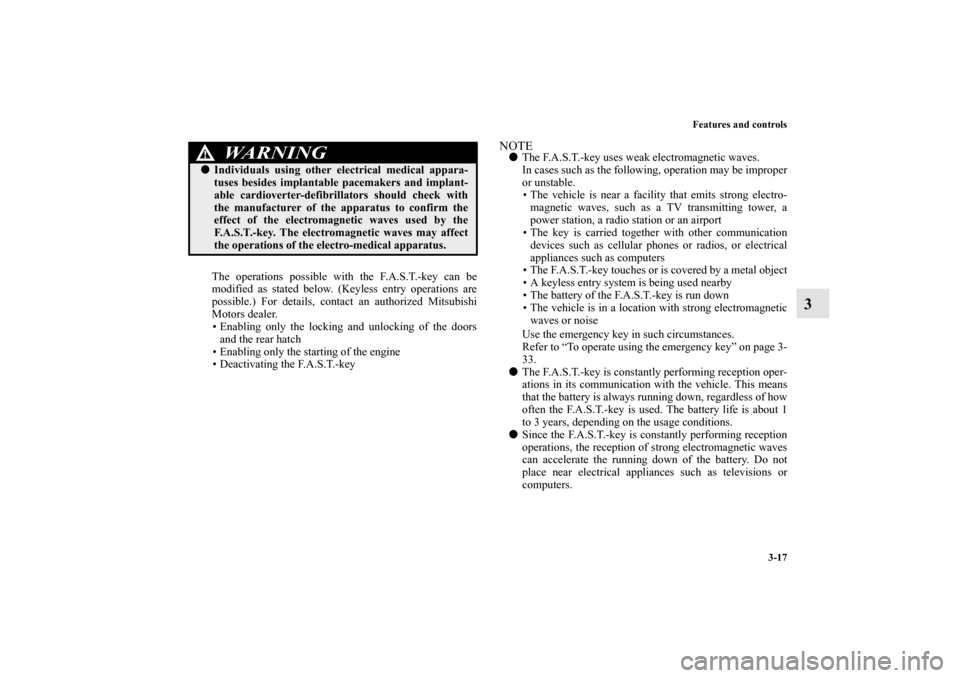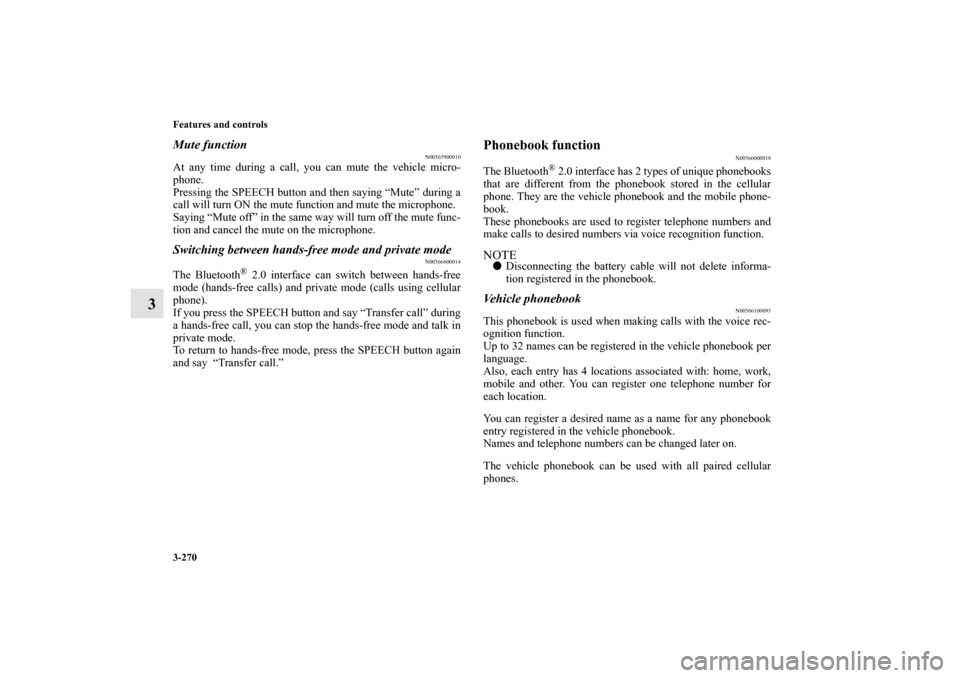Page 110 of 706

Features and controls
3-17
3
The operations possible with the F.A.S.T.-key can be
modified as stated below. (Keyless entry operations are
possible.) For details, contact an authorized Mitsubishi
Motors dealer.
• Enabling only the locking and unlocking of the doors
and the rear hatch
• Enabling only the starting of the engine
• Deactivating the F.A.S.T.-key
NOTE�The F.A.S.T.-key uses weak electromagnetic waves.
In cases such as the following, operation may be improper
or unstable.
• The vehicle is near a facility that emits strong electro-
magnetic waves, such as a TV transmitting tower, a
power station, a radio station or an airport
• The key is carried together with other communication
devices such as cellular phones or radios, or electrical
appliances such as computers
• The F.A.S.T.-key touches or is covered by a metal object
• A keyless entry system is being used nearby
• The battery of the F.A.S.T.-key is run down
• The vehicle is in a location with strong electromagnetic
waves or noise
Use the emergency key in such circumstances.
Refer to “To operate using the emergency key” on page 3-
33.
�The F.A.S.T.-key is constantly performing reception oper-
ations in its communication with the vehicle. This means
that the battery is always running down, regardless of how
often the F.A.S.T.-key is used. The battery life is about 1
to 3 years, depending on the usage conditions.
�Since the F.A.S.T.-key is constantly performing reception
operations, the reception of strong electromagnetic waves
can accelerate the running down of the battery. Do not
place near electrical appliances such as televisions or
computers.
WA R N I N G
!�Individuals using other electrical medical appara-
tuses besides implantable pacemakers and implant-
able cardioverter-defibrillators should check with
the manufacturer of the apparatus to confirm the
effect of the electromagnetic waves used by the
F.A.S.T.-key. The electromagnetic waves may affect
the operations of the electro-medical apparatus.
BK0151000US.book 17 ページ 2012年3月29日 木曜日 午後6時8分
Page 154 of 706
Features and controls
3-61
3
NOTE�Gas struts (B) are installed in the locations illustrated in
order to support the rear hatch. Please observe the follow-
ing in order to prevent damage or faulty operation.
• Do not touch, push or pull the gas struts when closing
the rear hatch.
• Do not attach any plastic material, tape, etc., to the gas
struts.
• Do not tie string, etc., around the gas struts.
• Do not hang objects on the gas struts.
Inside rear hatch release
N00523100058
The inside rear hatch release is designed to provide a way to
open the rear hatch if the battery is dead or disconnected.
The rear hatch release lever (see illustration) is mounted on the
rear hatch.
You and your family should familiarize yourselves with the
location and operation of the rear hatch release lever.
BK0151000US.book 61 ページ 2012年3月29日 木曜日 午後6時8分
Page 363 of 706

3-270 Features and controls
3
Mute function
N00565900010
At any time during a call, you can mute the vehicle micro-
phone.
Pressing the SPEECH button and then saying “Mute” during a
call will turn ON the mute function and mute the microphone.
Saying “Mute off” in the same way will turn off the mute func-
tion and cancel the mute on the microphone.Switching between hands-free mode and private mode
N00566600014
The Bluetooth
® 2.0 interface can switch between hands-free
mode (hands-free calls) and private mode (calls using cellular
phone).
If you press the SPEECH button and say “Transfer call” during
a hands-free call, you can stop the hands-free mode and talk in
private mode.
To return to hands-free mode, press the SPEECH button again
and say “Transfer call.”
Phonebook function
N00566000018
The Bluetooth
® 2.0 interface has 2 types of unique phonebooks
that are different from the phonebook stored in the cellular
phone. They are the vehicle phonebook and the mobile phone-
book.
These phonebooks are used to register telephone numbers and
make calls to desired numbers via voice recognition function.
NOTE�Disconnecting the battery cable will not delete informa-
tion registered in the phonebook.Vehicle phonebook
N00566100093
This phonebook is used when making calls with the voice rec-
ognition function.
Up to 32 names can be registered in the vehicle phonebook per
language.
Also, each entry has 4 locations associated with: home, work,
mobile and other. You can register one telephone number for
each location.
You can register a desired name as a name for any phonebook
entry registered in the vehicle phonebook.
Names and telephone numbers can be changed later on.
The vehicle phonebook can be used with all paired cellular
phones.
BK0151000US.book 270 ページ 2012年3月29日 木曜日 午後6時8分